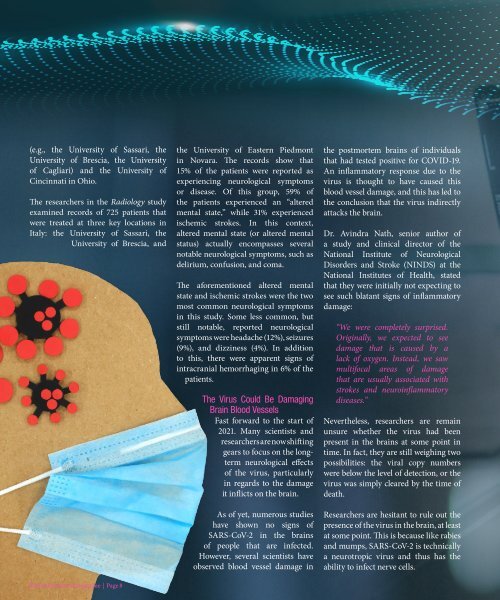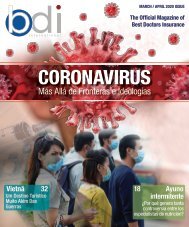You also want an ePaper? Increase the reach of your titles
YUMPU automatically turns print PDFs into web optimized ePapers that Google loves.
(e.g., the University of Sassari, the<br />
University of Brescia, the University<br />
of Cagliari) and the University of<br />
Cincinnati in Ohio.<br />
The researchers in the Radiology study<br />
examined records of 725 patients that<br />
were treated at three key locations in<br />
Italy: the University of Sassari, the<br />
University of Brescia, and<br />
the University of Eastern Piedmont<br />
in Novara. The records show that<br />
15% of the patients were reported as<br />
experiencing neurological symptoms<br />
or disease. Of this group, 59% of<br />
the patients experienced an “altered<br />
mental state,” while 31% experienced<br />
ischemic strokes. In this context,<br />
altered mental state (or altered mental<br />
status) actually encompasses several<br />
notable neurological symptoms, such as<br />
delirium, confusion, and coma.<br />
The aforementioned altered mental<br />
state and ischemic strokes were the two<br />
most common neurological symptoms<br />
in this study. Some less common, but<br />
still notable, reported neurological<br />
symptoms were headache (12%), seizures<br />
(9%), and dizziness (4%). In addition<br />
to this, there were apparent signs of<br />
intracranial hemorrhaging in 6% of the<br />
patients.<br />
The Virus Could Be Damaging<br />
Brain Blood Vessels<br />
Fast forward to the start of<br />
<strong>2021</strong>. Many scientists and<br />
researchers are now shifting<br />
gears to focus on the longterm<br />
neurological effects<br />
of the virus, particularly<br />
in regards to the damage<br />
it inflicts on the brain.<br />
As of yet, numerous studies<br />
have shown no signs of<br />
SARS-CoV-2 in the brains<br />
of people that are infected.<br />
However, several scientists have<br />
observed blood vessel damage in<br />
the postmortem brains of individuals<br />
that had tested positive for COVID-19.<br />
An inflammatory response due to the<br />
virus is thought to have caused this<br />
blood vessel damage, and this has led to<br />
the conclusion that the virus indirectly<br />
attacks the brain.<br />
Dr. Avindra Nath, senior author of<br />
a study and clinical director of the<br />
National Institute of Neurological<br />
Disorders and Stroke (NINDS) at the<br />
National Institutes of Health, stated<br />
that they were initially not expecting to<br />
see such blatant signs of inflammatory<br />
damage:<br />
“We were completely surprised.<br />
Originally, we expected to see<br />
damage that is caused by a<br />
lack of oxygen. Instead, we saw<br />
multifocal areas of damage<br />
that are usually associated with<br />
strokes and neuroinflammatory<br />
diseases.”<br />
Nevertheless, researchers are remain<br />
unsure whether the virus had been<br />
present in the brains at some point in<br />
time. In fact, they are still weighing two<br />
possibilities: the viral copy numbers<br />
were below the level of detection, or the<br />
virus was simply cleared by the time of<br />
death.<br />
Researchers are hesitant to rule out the<br />
presence of the virus in the brain, at least<br />
at some point. This is because like rabies<br />
and mumps, SARS-CoV-2 is technically<br />
a neurotropic virus and thus has the<br />
ability to infect nerve cells.<br />
<strong>BDI</strong> <strong>International</strong> <strong>Magazine</strong> | Page 8<br />
BestDoctorsInsurance.com | Page 9















